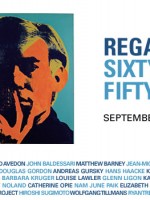The current show at the Metropolitan Museum in New York demonstrates the adage, “different strokes for different folks.” People of a certain age, who remember Warhol, his city and his entourage, his Factory and his every publicity-stoked action, react as though they are visiting old friends. Younger attendees, who did not experience the artist’s milieu, are reacting with a sense of delight and discovery.
For those of us who actually lived in that time and in that place, this exhibit evokes memories of the 60’s, of a city where all the old values and habits were turned on their ears, where everything seemed new and exciting and radical. At the time, Warhol and his gang were a constant, at auctions and fashion shows, spotted in bars and restaurants. They were everywhere; they were omnipresent. “I saw Ultra-Violet!” “I spotted Candy Darling.” “I just ran into Edie Sedgwick” or “I saw Nico in an elevator.” Max’s Kansas City, the Chelsea Hotel, seedy Union Square, all became places to be and to be seen, all because Warhol and his buddies hung out there.
We were being forced, some kicking and screaming, to look at art, and even more importantly, to think about art, in new and truly radical ways. The debates were endless and ongoing: “Is it art? What is art?” Whether we knew it or not, we were being forced to redefine the very terms of art and of life itself.
For people who were not around then, this exhibition is a really revealing demonstration that this artist has had a truly profound influence on many of those artists who have followed, consciously or unconsciously, in Warhol’s footsteps. 45 of Warhol’s works are mixed in with 100 works by other artists, demonstrating what critics have labeled “the obvious,” but stand to be looked at together.
As one enters the galleries, a recent piece by dissident Chinese artist Ai WeiWei says it all: it is an ancient-looking clay vessel, stenciled with the ubiquitous“Coca Cola” logo. Warhol’s work and such tributes to it as this piece have moved from the trendy to the eternal; they have permanently taken their place in the pantheon of great art.
Along with his iconic images, it is Warhol’s ideas, ideas that were once considered to be incredibly radical and controversial, that have seeped into the mainstream and are now permanently lodged in our culture. That the banal and commonplace are art: the Campbell’s can of tomato soup, the boxes of Brillo. That celebrities, like cans of soup or boxes of soap pads, are themselves commercial commodities, that they exist to be packaged and repackaged, mass-produced, advertised, sold and resold, and marketed to a fare-thee-well. In the current show, this notion is reflected in works by such artists as Jeff Koons, Robert Gober and Damien Hirst.
The idea of owning a unique piece of art was being constantly challenged by Warhol’s repeating images of Marilyn Monroe and his Jacqueline Kennedy, silk screened at his factory, and sold affordably to any and all. The artist’s conviction that art is profoundly and ultimately commercial had taken hold. Warhol believed and insisted that art was simply another aspect of the consumer culture that was thriving all around us. Its current manifestation, for example the ubiquitous presence of Damian Hirst’s dot paintings, is an undeniable expression of that truth. “Big Art is Big Money,” Warhol insisted. Other artists who use celebrity as a vehicle for their art include Jeff Koons, Cindy Sherman, Elizabeth Peyton and Chuck Close.
Another notion of Warhol’s that has taken tight hold is the idea that everyone deserves and insists upon their presence and time, his axiomatic 15 minutes, in the spotlight. Warhol presaged today’s reality television by noting, “”I’m really jealous of everybody who’s got their own show on t.v. I want a show of my own.”
Warhol was obsessed with the daily news, especially with disasters. The news of the day was a key component in his art. The influence of this notion is reflected in the show in works by Sigmar Polke and Hans Haake, while works by Vic Muniz and Sarah Lucas reflect our obsession with the news of the day.
It is easy to forget and important to remember that this was the time and the place when homosexuality became mainstream. Suddenly, amazingly, it was okay to be gay or lesbian, bisexual or out. Art reflected the sexual revolution that was taking place all around us. The section of the exhibition called “Queer Studies: Camouflage and Shifting Identities” demonstrates how true this is. Along with Warhol’s compelling and enigmatic “Self-portrait,” David Hockney’s “Boy about to Take a Shower,” and numerous works by such artists as Robert Mapplethorpe, Catherine Opie and Richard Avedon confirm that gay-ness is here to stay.
This is a large and complex show, one that has met with mostly negative reviews and reactions. (New York Magazine actually called it “shallow, pandering and feckless.”)But as one leaves to the gentle, mournful sound of Nico crooning, “What costume shall the poor girl wear—-to all tomorrow’s parties?” one realizes that it’s about more than the 60’s, more that Pop Art, it is about us all, and the pathways we have taken.
(“Regarding Warhol” is at the Metropolitan Museum in New York until December 31. An excellent catalogue published by the Museum and distributed by Yale University Press accompanies the exhibition.)
